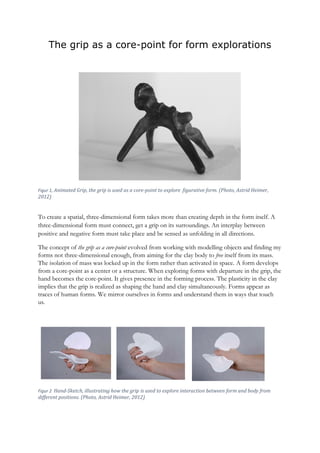Report
Share
Download to read offline

Recommended
Recommended
More Related Content
Similar to The grip as a core-point
Similar to The grip as a core-point (10)
Chapter Five Principles of DesignUnityVariety Repetition.docx

Chapter Five Principles of DesignUnityVariety Repetition.docx
The grip as a core-point
- 1. The grip as a core-point for form explorations Figur 1, Animated Grip, the grip is used as a core-point to explore figurative form. (Photo, Astrid Heimer, 2012) To create a spatial, three-dimensional form takes more than creating depth in the form itself. A three-dimensional form must connect, get a grip on its surroundings. An interplay between positive and negative form must take place and be sensed as unfolding in all directions. The concept of the grip as a core-point evolved from working with modelling objects and finding my forms not three-dimensional enough, from aiming for the clay body to free itself from its mass. The isolation of mass was locked up in the form rather than activated in space. A form develops from a core-point as a center or a structure. When exploring forms with departure in the grip, the hand becomes the core-point. It gives presence in the forming process. The plasticity in the clay implies that the grip is realized as shaping the hand and clay simultaneously. Forms appear as traces of human forms. We mirror ourselves in forms and understand them in ways that touch us. Figur 2 Hand-Sketch, illustrating how the grip is used to explore interaction between form and body from different positions. (Photo, Astrid Heimer, 2012)